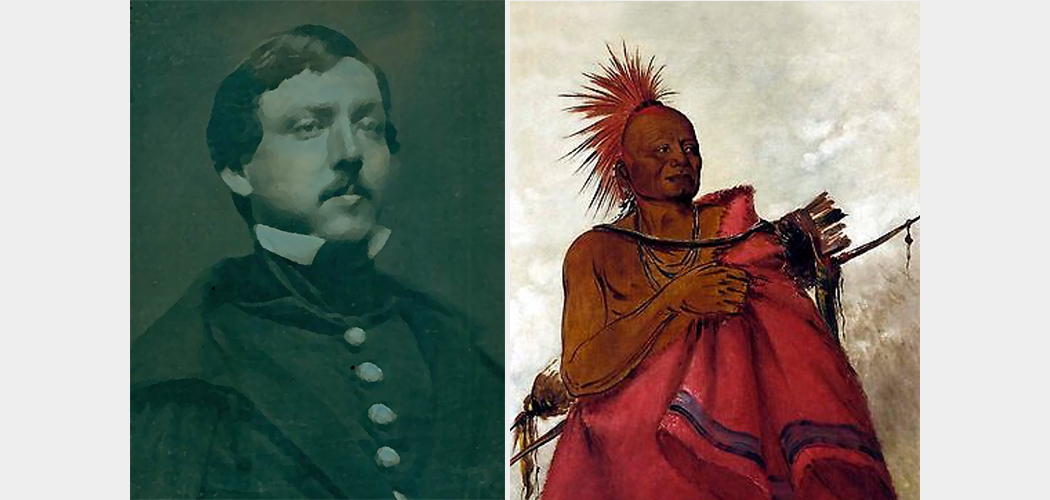[title subtitle=”words: Tom Wing, Historian
images: Mad Buffalo by George Catlin courtesy of the Gilcrease Museum via Tom Wing; Photo of Martin Scott courtesy of the Bennington Museum via Tom Wing “][/title]
Fort Smith’s history includes a number of recognizable soldiers who were associated with the post. A few became generals and one even president. One soldier, who would have likely been among those remembered had his life taken a different turn, was Martin Scott. Author and historian Frank Jastrzembski has recently chronicled his amazing life.
Born in Bennington, Vermont, in 1788, Scott had a reputation for being a crack shot. At twelve years old, he shot and killed a bear that had been terrorizing local farms. Another story notes an occasion where Scott shot the center of a playing card at seventy-five yards, three times in a minute-twenty seconds. Yet another tale, perhaps tall, but likely grounded in some fact, tells of Scott and two friends hunting. Scott’s associates proceeded up a trail where they both missed the same raccoon. When Scott appeared, ready to take the shot and bag the animal, the raccoon surrendered and was taken alive out of fear of Scott’s reputation with a rifle.
In 1814, he received a commission to serve in the army and was soon promoted to second lieutenant. In 1818 he joined the elite Rifle Regiment and rose to the rank of first lieutenant.
He spent time at a number of frontier posts in the west, until he was transferred to Major William Bradford’s company at Fort Smith, dubbed the “Little Gibraltar on the Arkansas,” in 1821.
At that time, the fort, established in 1817 to settle the peace between the removed Cherokee and the relocated Osage, was holding its own. But it was understaffed due to illness, ending of enlistments, and a few desertions. To remedy this, Major Bradford traveled to St. Louis to recruit and enlist replacements. This left the fort in the hands of a newly transferred First Lieutenant, Martin Scott.
History tells of many instances where untried, inexperienced rookies must sink or swim in pressured situations. Reputations that last a lifetime are made under such conditions. April 9, 1821, was one of those times. The day dawned like any other fine Western Arkansas spring day, with the exception of the post being alerted to 400 Osage warriors on the opposite shore across from the fort, harassing soldiers’ families who lived in a cluster of cabins located there.
Led by Tcha-to’-ga (Mad Buffalo) and six other leaders, the war party occupied the Loving family cabin, threatening Susan Loving and her children, while her husband was on duty in the fort. Lieutenant Scott sent emissaries across the river to escort the Osage leaders to the fort. He also specified that the 400 warriors were not to cross. Scott described the “haughty” demeanor of the group and that they refused food and drink.
Scott explained the government’s position of neutrality to Mad Buffalo and the other leaders. His words were met with the Osage’s demands for provisions, ammunition, and permission to bring the war party across the river and camp beside the fort. During the discussion, the group “minutely examined every part of the fort and were anxious to know how many soldiers were at the post.” Scott noted “there was little doubt of their hostility towards the garrison.” Once the leaders crossed back over the river, the Osage were seen cutting trees, lashing logs and making rafts. A small group of warriors was discovered on the fort side of the river, hiding in a cane break below the post. With these provocations, Lieutenant Scott ordered the two six-pounder cannons to be loaded and set up outside the fort in view of the war party. This show of firepower caused the raft-building to stop, and the cane break invaders retreated. The entire war party then proceeded downstream, on the north bank, where they murdered six people, three Quapaw and three Delaware tribal members who were friendly to the Cherokee. The group also plundered and robbed settlers on Lee Creek, and made off with a large number of stolen horses. Scott noted that “no whites” were harmed and the soldiers’ families, while no doubt traumatized, were not injured.
Scott’s account was published anonymously in the Arkansas Gazette on April 23, 1821. “Their covenant in attempting to get in the fort by strategizing, their exertions made use of to attain that object, their hostile appearance and insolent demands for provisions and ammunition, together with their landing parties above and below us, can only be viewed as a violation of good faith towards our government, checked by energetic and decisive measures.”
In 1824, three years after the article appeared, Fort Smith was abandoned, its mission mostly accomplished, with some credit due to Scott. The Rifle Regiment was disbanded at the same time, and Scott eventually became a Lieutenant Colonel in the 5th Infantry. In 1847, he died leading his men at the Battle of Molino Del Rey in the Mexican War.
Years later, Osage oral history somewhat disputed Scott’s account, explaining the 400 warriors could have conquered the Cherokee, but one of the leaders experienced a bad dream and interpreted it as an evil omen. Therefore, the hostility towards the fort was abandoned by choice and not the actions of the Lieutenant.
The details of the dream remain unknown, lost to time, but one has to wonder if it might have involved a few pounds of black powder, a quantity of iron shot, and two cannon barrels mounted on wooden carriages. If so, perhaps both Martin Scott’s and the Osage accounts might actually agree.
For more information about Martin Scott, visit emergingcivilwar.com/2017/05/15/the-mythical-martin-scott/.
For information about Osage oral history, read The Chouteaus: First Family of the Fur Tradeby Stan Hoig.




